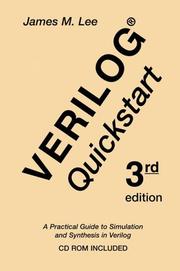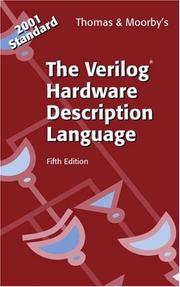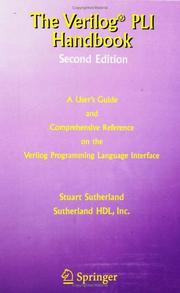| Listing 1 - 4 of 4 |
Sort by
|
Book
ISBN: 0738135011 073813502X Year: 2002 Publisher: New York : Institute of Electrical and Electronics Engineers (IEEE),
Abstract | Keywords | Export | Availability | Bookmark
 Loading...
Loading...Choose an application
- Reference Manager
- EndNote
- RefWorks (Direct export to RefWorks)
Standard syntax and semantics for Verilog HDL-based RTL synthesis are described in this standard.

ISBN: 0792376722 9786610206360 1280206365 0306476800 Year: 2002 Publisher: Boston : Kluwer Academic Publishers,
Abstract | Keywords | Export | Availability | Bookmark
 Loading...
Loading...Choose an application
- Reference Manager
- EndNote
- RefWorks (Direct export to RefWorks)
From a review of the Second Edition 'If you are new to the field and want to know what "all this Verilog stuff is about," you've found the golden goose. The text here is straight forward, complete, and example rich -mega-multi-kudos to the author James Lee. Though not as detailed as the Verilog reference guides from Cadence, it likewise doesn't suffer from the excessive abstractness those make you wade through. This is a quick and easy read, and will serve as a desktop reference for as long as Verilog lives. Best testimonial: I'm buying my fourth and fifth copies tonight (I've loaned out/lost two of my others).' Zach Coombes, AMD.
Logische schakelingen. --- Verilog (Computer hardware description language). --- Engineering. --- Computer hardware. --- Computer-aided engineering. --- Electrical engineering. --- Electronic circuits. --- Circuits and Systems. --- Computer Hardware. --- Electrical Engineering. --- Computer-Aided Engineering (CAD, CAE) and Design. --- Verilog (Computer hardware description language) --- Systems engineering. --- Computer engineering. --- Computer aided design. --- Computers. --- CAE --- Engineering --- Electric engineering --- Electron-tube circuits --- Electric circuits --- Electron tubes --- Electronics --- Data processing --- Verilog hardware description language (Computer hardware description language) --- Computer hardware description languages --- Integrated circuits --- Computer simulation

ISBN: 1402070896 1280201517 9786610201518 0306476665 Year: 2002 Publisher: New York : Kluwer Academic Publishers,
Abstract | Keywords | Export | Availability | Bookmark
 Loading...
Loading...Choose an application
- Reference Manager
- EndNote
- RefWorks (Direct export to RefWorks)
This text presents the IEEE 1364-2001 standard of the Verilog language. The examples in this edition have been updated to illustrate the features of the language. A cross referenced guide to these features is provided, thus, designers already familiar with Verilog can quickly learn the features. Newcomers to the language can use it as a guide for reading "old" specifications.; The book should prove to be a useful resource for engineers and students interested in describing, simulating and synthesizing digital systems. It is also ready for use in university courses, having been used for introductory logic design and simulation through advanced VLSI design courses. An appendix with tutorial help and a work-along style is keyed into the introduction for new students. Material supporting a computer-aided design course on the inner working of simulators is also included.; "The Verilog TM Hardware Description Language" includes a CD containing Simucad's Silos TM 2001 Verilog Simulator, examples from the book and lecture slides. The simulator is limited in the size of descriptions it will simulate. A few of the language constructs are not recognized by this version of the simulator.
Verilog (Computer hardware description language) --- Microelectronics. --- Verilog hardware description language (Computer hardware description language) --- Computer hardware description languages --- Engineering. --- Programming languages (Electronic computers). --- Computers. --- Computer-aided engineering. --- Electrical engineering. --- Electronics. --- Electronic circuits. --- Circuits and Systems. --- Programming Languages, Compilers, Interpreters. --- Theory of Computation. --- Computer-Aided Engineering (CAD, CAE) and Design. --- Electronics and Microelectronics, Instrumentation. --- Electrical Engineering. --- Integrated circuits --- Computer simulation --- Engineering --- Technology & Engineering

ISBN: 1280201509 9786610201501 0306476657 0792376587 Year: 2002 Publisher: New York, New York ; Boston, Massachusetts : Kluwer Academic Publishers,
Abstract | Keywords | Export | Availability | Bookmark
 Loading...
Loading...Choose an application
- Reference Manager
- EndNote
- RefWorks (Direct export to RefWorks)
by Maq Mannan President and CEO, DSM Technologies Chairman of the IEEE 1364 Verilog Standards Group Past Chairman of Open Verilog International One of the major strengths of the Verilog language is the Programming Language Interface (PLI), which allows users and Verilog application developers to infinitely extend the capabilities of the Verilog language and the Verilog simulator. In fact, the overwhelming success of the Verilog language can be partly attributed to the exi- ence of its PLI. Using the PLI, add-on products, such as graphical waveform displays or pre and post simulation analysis tools, can be easily developed. These products can then be used with any Verilog simulator that supports the Verilog PLI. This ability to create thi- party add-on products for Verilog simulators has created new markets and provided the Verilog user base with multiple sources of software tools. Hardware design engineers can, and should, use the Verilog PLI to customize their Verilog simulation environment. A Company that designs graphics chips, for ex- ple, may wish to see the simulation results of a new design in some custom graphical display. The Verilog PLI makes it possible, and even trivial, to integrate custom so- ware, such as a graphical display program, into a Verilog simulator. The simulation results can then dynamically be displayed in the custom format during simulation. And, if the company uses Verilog simulators from multiple simulator vendors, this integrated graphical display will work with all the simulators.
Verilog (Computer hardware description language) --- Systems engineering. --- Computer hardware. --- Computer aided design. --- Computer engineering. --- Circuits and Systems. --- Computer Hardware. --- Computer-Aided Engineering (CAD, CAE) and Design. --- Electrical Engineering. --- Electronic circuits. --- Computer-aided engineering. --- Electrical engineering. --- Electric engineering --- Engineering --- CAE --- Electron-tube circuits --- Electric circuits --- Electron tubes --- Electronics --- Data processing --- Computer interfaces. --- Verilog hardware description language (Computer hardware description language) --- Computer hardware description languages --- Integrated circuits --- Interfaces, Computer --- Computer input-output equipment --- Interface circuits --- Computer simulation
| Listing 1 - 4 of 4 |
Sort by
|

 Search
Search Feedback
Feedback About UniCat
About UniCat  Help
Help News
News